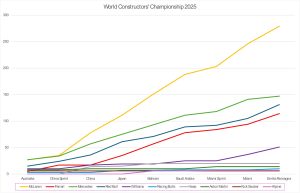Mexican GP
General
Imola Circuit or Autodroma Enzo e Dino Ferrari did not disappoint as an exciting race venue and produced a scintillating weekend of racing. This old-fashioned circuit requires precision from the drivers and exacting performance from the cars. The circuit was inaugurated in 1953 but did not hold a championship Grand Prix until 1980. That was the Italian Grand Prix which was won by Nelson Piquet in a Brabham-Ford. In 2020 covid brought us the first Emilia Romagna Grand Prix (Gran Premio dell’Emilia-Romagna) to assist in filling out the race calendar for that year. Since then, except for 2023 when the area was flooded, we have had this GP. Now it seems unlikely that we will have it next year.
Amusing
Of amusement to me was the McLaren saying of Forever Forward going sideways on the automatic doors of their hospitality suit.
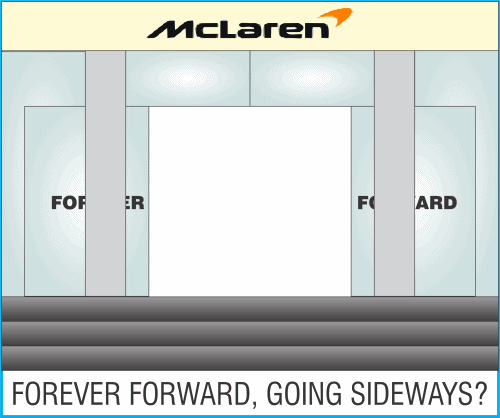
Going sideways for Lando Norris or Oscar Piastri?
Where McLaren are not going sideways is regarding the legality of their cars. After all the inuendo from other teams (mainly Red Bull) about McLarens lack of tyre degradation being something illegal, their cars were scrutinised by the FIA after the Miami GP. The FIA’s final report stated categorically that the McLaren cars were entirely within the F1 technical regulations.
So, none of this-![]()
or this-
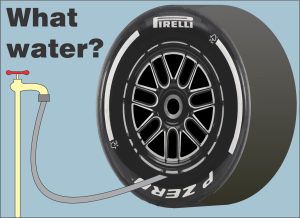
Updates
Car updates galore. Being back in Europe and closer to the constructors’ facilities, most teams have updates to their cars.
- McLaren
- revised rear corner and suspension to improve airflow conditioning and rear downforce
- high-downforce rear and beam wing combination, focused on creating more local load on the mainplane and flap
- front suspension modification to improve component clearance
- Red Bull
- revised radiator duct inlet
- revised rear suspension fairing
- revised wheel bodywork
- revised exit ducts
- Mercedes
- modified front suspension
- reshaped front wing
- the engine cover modified to improve engine cooling
- reprofiled suspension fairings
- Ferrari
- reshaped high-downforce rear and beam wing combination
- revised rear scoop geometries
- Aston Martin
- revised halo
- revised floor body
- revised floor fences
- revised floor edges
- revised diffuser
- revised engine cover
- revised beam wing
- Haas
- new floor body shape
- new floor edge
- new diffuser has been designed to work in conjunction with these parts while, at the rear, the
- revised rear brake duct lower element
- revised lower suspension fairing
- Alpine
- reprofiled front wing and flap
- reprofiled rear bodywork panel
- Racing Bulls
- new floor
- new side pods
- new halo end winglets added.
Williams and Sauber nothing declared other than the high downforce rear wings which are circuit specific
Perelli have issued the C6 grade of tyre for the first time. It is a new softer compound which is reminiscent of bygone eras when there was qualifying only tyres or more recently Super Soft tyres. Last year it was C3, C4 and C5 for hard, medium and soft respectively. This year it is C4, C5 and C6.
Free Practice 1
Carlos Sainz (Williams) was caught speeding in the pitlane. He was clocked at 93.7 kilometres per hour in the 80 kilometres per hour zone. His team was fined €1000.
Ferrari were fined €5000 for altering the tyre pressure on Charles Leclerc’s car without taking the tyre temperature into account. Technical directive TD003G provides the multiple use of tyres during a session but if the pressure is modified then the pressure can not be lower that a certain level according to the temperature of the tyre. As this is a safety issue and that Ferrari have been in breach of this on prior occasions, the fine was applied.
With only a few minutes remaining of FP1, Gabriel Bortoleto (Kick Sauber) took too much curb at turn 18 and went straight into the barriers. This ended the session.
With the top 5 drivers within 0.1 seconds, it was a great session-
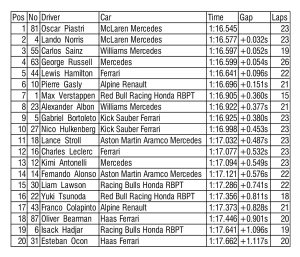
Free Practice 2

Plenty of laps run on the soft and medium tyres. McLaren still the performing team.
Free Practice 3
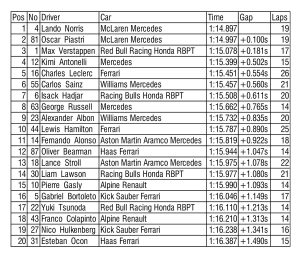
Still McLaren cars faster than anybody else but this time with Lando Norris ahead of Oscar Piastri. The soft C6 tyres seem to be a problem as they seem to go off at the end of a lap.
All the practice performances are shown on this graph-
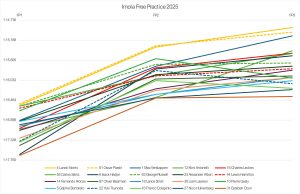
QUALIFYING
Qualifying One (Q1)
On a circuit where traffic can be a problem, drivers wasted no time getting out to set a time.
5 minutes 40 seconds into Q1, 10 drivers had set a time when yellow flags were shown. 7 seconds later, the flags turned red. Yuki Tsunoda (Red Bull) had a horrific looking crash into turn six. His car was flipped over along the crash barriers, landing upside-down, before rebounding upright. He was not injured but badly shaken up. His teammate Max Verstappen had just finished sector one in a very fast, purple, time of 23.849 seconds and with the session stopped, had to abandon the lap.
After a lengthy delay to recover Yuki Tsunoda’s car and repair the barrier, the session resumed.
With many drivers on their second Q1 runs, Franco Colapinto (Alpine) put paid to anyone improving their lap times. He brought out the red flag in the final 30 seconds of the session. He put a wheel over the kerb and onto the grass in turn 3, spun off the track and slammed nose-first into the barrier. Franco reported the crash over the radio and said he was all right. His first run had put him in 15th position on the grid.
Franco’s woes were not just his crash, but the 1 place grid place penalty earned just before the crash. The FIA announced a time for Q1 to be resumed, pending confirmation. Before the confirmation came through Franco was waved out of his garage and he went into the fast pit lane. Drivers are only allowed into the fast pitlane when start or restart times are confirmed. Very technical but in the rules.
Max Verstappen (Red Bull) topped the timing charts with a 1:15.175 time, 0.325 seconds ahead of Oscar Piastri (McLaren).
The drivers eliminated were Liam Lawson (Racing Bulls), Nico Hulkenberg (Kick Sauber), Esteban Ocon (Haas), Oliver Bearman (Haas) and Yuki Tsunoda (Red Bull).
Qualifying Two (Q2)
The 15 minutes of Q2 was uneventful compared to the mayhem of Q1.
Carlos Sainz (Williams) topped the timing charts with a 1:15.198 which was 0.016 seconds faster than Oscar Piastri (McLaren). What a lap from Carlos with a 0.789 second improvement over his Q1 time.
All the drivers apart from Max Verstappen (Red Bull), improved on their Q1 times. Max ended up 0.219 seconds slower after a wobble in the second sector.
A black day for Ferrari with their cars just not quick enough to go through to Q3. Local driver Kimi Antonelli (Mercedes) also disappointed his fans (tifosi) in not making Q3.
Eliminated were Charles Leclerc and Lewis Hamilton in Ferraris, Kimi Antonelli (Mercedes), Gabriel Bortoleto (Kick Sauber) and Franco Colapinto (Alpine) who of course set no Q2 time.
Qualifying Three Q3
What a delight in seeing these beautifully liveried racing cars at their very fastest pace storming around a gorgeous circuit. Conditions could not be better with a 23 degree air temperature, 39 degree track temperature and a mild 7 km/h breeze. It just cannot get better.
Reality is that for this narrow circuit the F1 cars are just too wide and heavy with too much air disturbance so that they impede each other. A perfect qualifying experience would be as they did it in bygone eras where each car went off separately, in clean air, to set a time.
Nowadays the compromise must be made between going out early in a session to find that clean air and going out later when the circuit surface is at its absolutely best for traction.
Tyres played a part in this qualifying. Usually only the softest tyre is selected for all the qualifying sessions. Occasionally the faster cars may use a medium tyre in Q1 knowing that their pace will get them through to Q2 even on those. Here, with the first use of the C6 compound, some drivers found that they could not get optimum performance from these over a full lap.
Aston Martin, who brought a huge number of updates for their cars, found out that their cars performed better in the medium tyres. This proved correct as their drivers were third and fourth in Q1, sixth and seventh in Q2 and ended up fifth and eighth in Q3. Fernando Alonso ahead of Lance Stroll in each case. George Russell (Mercedes) also gambled on the medium tyres to good effect and ended up third in Q3.
The results of the Q3 session with tyre choice-
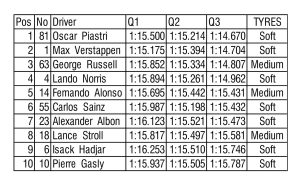
And graphically for the top ten qualifiers-

THE RACE
When the lights went off Oscar Piastri and George Russell made good starts while Max Verstappen seemed slow off the line. Halfway down that very long 400 meter stretch to turn 1 George was alongside Max. On the sweep into turn 1 Oscar covered the centre line as he braked. Max braked so late a crash or run off the circuit looked like the only outcome. But no, his car kept its inside line with outside wheels well within the circuit limits and sweeping into turn 2 he was ahead, leading the race.
That move on Oscar Piastri by Max Verstappen was reminiscent of Max’s move on the then world drivers’ championship leader Nico Rosburg at the 2016 Brazilian GP. A GP that a rival team principal Toto Wolff called “The Verstappen Show”, and that Max “redefined physics”. This was after he had pitted for wet tyres and was in 16th place with only 15 laps remaining in the race. He stormed through 13 of those drivers ahead of him to finish the race on the podium in third place.
Back to Imola. By start of the second lap Max was already 0.974 seconds ahead of Oscar. By the time they both got through the first sector on that second lap, the gap was 1.284 seconds so even though DRS was enabled, it was of no use to Oscar.
Lando Norris (McLaren) was trying to overtake George Russell (Mercedes) for 11 laps. Eventually Lando got passed George in lap 12 and George immediately pitted for fresh tyres. George had radioed about issues with his car’s performance and tyres, but he successfully defended against Lando.
Oscar Piastri pitted on lap 14. His pitstop had a stationary time of 3.6 seconds which was very slow by McLaren standards. He came out into traffic and took a long time to get briefly back to second in lap 31.
Lando Norris pitted on lap 29. On lap 30 there was a Virtual Safety Car (VSC) caused by Esteban Ocon (Haas) who stopped with a car issue. Max Verstappen pitted and retained the lead of the race. Max was ahead of Oscar Piastri who did not pit.
Oscar Piastri, who was on old tyres, was soon overtaken by Lando Norris and Alex Albon (Williams) who were both on fresh tyres.
On lap 47 Race Control called for a full Safety Car (SC) due to Kimi Antonelli (Mercedes) having pulled off the circuit with an accelerator problem. Max Verstappen pitted and retained his lead of the race.
When the SC came in on lap 53, it left a ten lap sprint to the finish. Tyre age was interesting. All the drivers were on hard tyres except Nico Hulkenberg and Yuki Tsunoda who were on mediums. Fresher tyres were king in most cases.
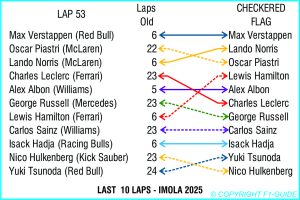
This lap chart tells most of the story of the race-
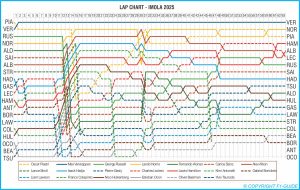
For a start to checkered flag picture-
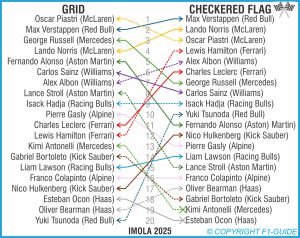
Championship Standing After Seventh Venue
World Drivers’ Championship
Points
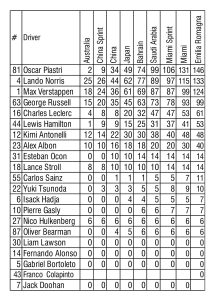
Graph
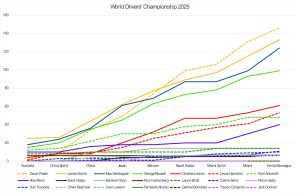
World Constructors’ Championship
Points
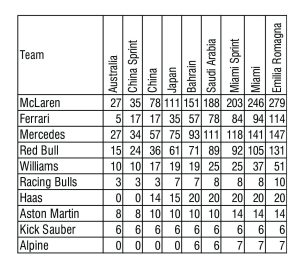
Graph
